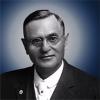 Submitted by Heindel on
Submitted by Heindel on

One day in Santa Barbara, Cal., a man by the name of Roberts came to a trained clairvoyant who is also a lecturer on Theosophy and asked for help in a perplexing case. Mr. Roberts had been walking in the street the previous day when a little three-year old girl came up to him and put her arms around his knees, calling him papa. Mr. Roberts was indignant, thinking that someone was trying to father the child on him. But the mother of the child, who came up directly, was equally put out and tried to get the child away. The child, however, kept on clinging to Mr. R., insisting that he was her father. On account of circumstances to be told later Mr. R. could not put it out of his mind, and sought out the clairvoyant, who accompanied him to the house of the child's parents. Where the girl at once ran up to Mr. R. and again called him papa. The clairvoyant, whom I call X, first took the child over to the window to note whether the iris of the eye would expand and contract when he turned her to and from the light, in order to see whether another entity than the rightful owner was in possession of the child's body, for the eye is the window of the soul and no "obsessing" entity can secure control of that part. Mr. X. found however, that the child was normal and next proceeded to question the little one carefully. After patient work carried on intermittently during the afternoon, so as not to tire the child, this is the story she told:
She had lived with her papa, Mr. Roberts, and another mamma in a little house that stood all alone, where no other house could be seen; there was a little brook close to the house where some flowers grew (and here she ran out and brought in some "pussy-willows") and there was a plank across the brook which she was cautioned against crossing, for fear she might fall into the brook. One day her papa had left her mother and herself and had not returned. When their supply of food was exhausted her mamma lay down on the bed and became so still. At last she said quaintly, "then I also died, but I didn't die. I came here."
Mr. Roberts next told his story. Eighteen years before he lived in London, where his father was brewer. He fell in love with their servant girl. His father objected, so he eloped with her to Australia after they had first been married. Here he went out into the bush and cleared a little farm, where he erected a small cabin by a brook, just as described by the little girl. A daughter was born to them there, and when she was about two years old he left the house one morning and went to a clearing some distance from the house, and while there a man with a rifle came up to him, saying that he arrested him in the name of the law for a bank robbery committed on the night Mr. R. had left England. The officer had tracked him here, thinking him the criminal. Mr. R. begged to be allowed to go to his wife and child, but, thinking this a ruse to entrap him into the hands of confederates, the officer refused and drove him to the coast at the point of the gun. He was taken to England and tried and his innocence proven.
First then did the authorities take heed of his constant ravings about his wife and child, whom he knew must starve in that wild and lonely country. An expedition was sent out to the cabin, when it was found that only the skeletons of the wife and child remained. Mr. Roberts' father had died in the meantime, and though he had disinherited Mr. R. his brothers divided with him and he came to America a broken man.
He then produced photographs of himself and his wife, and at the suggestion of Mr. X. they were mixed with a number of other photographs and shown to the little girl, who unhesitatingly picked out the photographs of both her alleged parents, although the photograph shown was very different from the present appearance of Mr. Roberts.
From: The Rosicrucian Cosmo-Conception, Chapter IV, Rebirth and the Law of Consequence
Max Heindel
- 495 reads